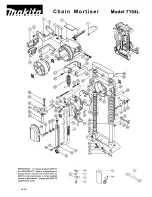
27
GB
Introduction / General safety advice for electrical power tools
Introduction
for the comparison of appliances. The vibration
emission value specified can also serve as a prelim-
inary assessment of the exposure.
Different uses of the device give rise to different vi-
bration levels and in many cases they may exceed
the values given in these instructions. It is easy to
underestimate the vibration load if the electrical
power tool is used regularly in particular circum-
stances.
Note:
If you wish to make an accurate assessment
of the vibration loads experienced during a particu-
lar period of work, you should also take into account
the intervening periods of time when the device is
switched off or is running but is not actually in use.
This can result in a much lower vibration load over
the whole of the work period.
General safety advice for
electrical power tools
Please read all safety
information and instructions.
Failure to ob-
serve the safety information and instructions can
result in electric shock, fire and / or serious injury.
For future reference keep all the safety
advice and instructions in a safe place.
The term “electrical tool” used in the safety advice
refers to electrical tools powered by mains electric-
ity (by means of a mains lead) and electrical tools
powered by rechargeable batteries (without a
mains lead).
1. Workplace safety
a)
Keep your working area clean and
well lit.
Untidy or poorly lit working areas
can lead to accidents.
b)
Do not work with the device in poten-
tially explosive environments, which
contain inflammable liquids, gases or
dusts.
Electrical power tools create sparks,
which can ignite dusts or fumes.
c)
Keep children and other people away
while you are operating the electrical
tool.
Distractions can cause you to lose con-
trol of the device.
2. Electrical safety
a)
The mains plug on the device must
match the mains socket. The plug
must not be modified in any way. Do
not use an adapter plug with devices
fitted with a protective earth.
Unmodified
plugs and matching sockets reduce the risk of
electric shock.
b)
Avoid touching grounded surfaces
such as pipes, radiators, ovens, and
refrigerators.
There is an increased risk of
electric shock if your body is earthed.
c)
Keep the appliance away from rain
or moisture.
The penetration of water into
the electrical device increases the risk of an
electric shock.
d)
Do not use the mains lead for purpos-
es it was not intended for, e.g. to carry
the device, to hang up the device or to
pull the mains plug out of the mains
socket. Keep the mains lead away
from heat, oil, sharp edges or moving
parts of the device.
Damaged or tangled
cables increase the risk of an electric shock.
e)
If you are working outdoors with an
electrical power tool, always use ex-
tension cords that are approved for
outdoor use.
The use of an extension cable
suitable for outdoor use reduces the risk of
electric shock.
f)
Use a residual current device (RCD)
for protection if the operation of the
electrical power tool in a moist envi-
ronment cannot be avoided.
The use of
an RCD reduces the risk of electric shock.
3. Personal safety
a)
Remain alert at all times, watch what
you are doing and always proceed
79416_par_Tauchsaege_Content_DE-AT-NL.indd 27
07.12.12 12:47








































